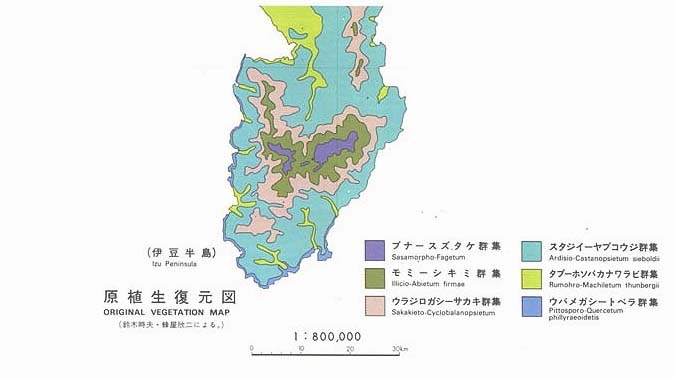
|
12.
|
日本の植生 VEGETATION OF JAPAN |
||
|
植生の地域区分 日本の自然条件のもとに成立する植生は、本来大部分が森林である。ほとんどの場合何らかの原因で裸地ができても遷移の進行を経て最終的には森林となる。日本の森林は、水平的には南から北へ向かって温度の変化にともない常緑広葉樹林、落葉広葉樹林、常緑針葉樹林と変化する。垂直的にも標高が増すにつれてより低温になるためほぼ水平的な森林の変化と一致する。これらの森林の配置は帯状なので古くから森林帯とよばれており、明治以来多くの人によってさまざまな区分が提唱されている。現在広く使われている区分の一つによれば、常緑広葉樹林は暖帯林(カシ帯)、落葉広葉樹林は温帯林(ブナ帯)、常緑針葉樹林は寒帯林(トドマツ・シラベ帯)とされている。このような相観とともに、おもに群落の種組成から出発して、それをつみあげる植物社会学的な区分もいろいろとおこなわれている。本書で用いている区分のヤブツバキクラス域は常緑広葉樹林に、ブナクラス域は落葉広葉樹林に、亜寒帯・亜高山帯自然植生は常緑針葉樹林にほぼ相当する。 また、その内容について本書の現存植生図で用いているクラス域ごとにみてみると、ヤブツバキクラス域では、タブやシイ類などが海岸近くの森林を構成し、カシ類が内陸部の森林のおもな構成種となる。急斜面や尾根すじでは、モミ、ツガがみられる。太平洋岸の土壌の浅い海岸ではウバメガシが育ち、やせた尾根すじをアカマツが占める。古くから人為的影響をうけており、自然植生の残っているところは少ない。またブナクラス域においては、ブナを代表種として、尾根すじや乾いた斜面にはミズナラの多い林、谷すじにはヤチダモ、シオジ、カツラ、トチノキなどがみられる。林床にササの多いことは世界の他の地域ではみられない。雪の多い日本海側と雪の少ない太平洋側では、ブナ林でもササの種類がことなる。この地域も人為による植生の改変がすすんでいる。つぎに亜寒帯・亜高山帯自然植生は、本州の山地ではシラベ、アオモリトドマツ、コメツガなどがおもな構成樹種であり、北海道ではエゾマツ、トドマツで代表されるが落葉広葉樹が混交することが多い。本州の山地では伐採と植林がすすんでおり、北海道でも植林地、伐採の影響を強く受けた天然林が多くなっている。 人為と植生 人為の影響をまったくうけずに生育する植生を自然植生というが、前述の区分は、この自然植生によっておこなったものである。人間が影響を与える以前の自然植生を原植生、あるいは原始植生とよぶ。 現実に存在する植生は人間のさまざまな活動によって自然植生とはちがったものとなっている。例えば、農業、林業、畜産などの人間の営みによって、水田、畑地、植林地、草地などのまったく人工的な群落に変わっているし、山火事や絶えざる伐採によって遷移の途中段階まで戻った森林も多い。このような人為の影響を強くうけて変わった植生を代償植生とよび、自然植生と代償植生が混じっている現状の植生を現存植生とよんでいる。もしこの現存植生から人為の影響がまったくなくなったとしても、土地条件がすでに変わっているため、必ずしも原植生にはもどらない。その時点における土地条件のもとで支え得る終局の植物群落を推定して潜在自然植生とよんでいる。 (佐藤大七郎) |
Zonation of Vegetation In the natural environment of Japan, the vegetation is mainly forest. With the change in temperature, Japanese forests change from south to north in the order of evergreen broadleaved, deciduous broadleaved, and evergreen coniferous forests-Vertically, a similar pattern of vegetational change occurs with change in temperatute. The pattern of distribution of these types of forests is zonal and it is called forest zone, and many types of classification have been proposed since the late 1800's. According to one of the most popularly used classifications, evergreen broadleaved forest is called warm temperate forest zone or evergreen oak (Cyclobalanopsis spp.) zone, deciduous broadleaved forest is cool temperate forest zone or beech (Fagus crenata) zone, evergreen coniferous forest is called boreal forest zone or Abies sachalinensis/ A. veichii zone. Beside these classifications based on physiognomy, these are a variety of versions of phytosociological classification based on species composition of plant communities. The classification used in this book is one of those phytosociological classifications: Camellietea-japonicae Region is equivalent to evergreen broadleaved forest zone, Fagetea-crenatae Region is deciduous broadleaved forest zone, and subarctic and subalpine natural vegetation represents evergreen coniferous forest zone, roughly speaking. Some features of the areas presented in the Actual Vegetation Map in this book are as follows. In Camellieta-japoncae, Machilus thunbergii and Castanopsis spp. grow in forests near the seaside, whereas evergreen oaks (Cyclobalanopsis spp.) dominate the inland forests. On steep slopes and ridges, Abies firma and Tsuga sieboldii are found. On tha shallow soil of the seacoasts along the Pacific Ocean Quercus phylliraeoides grows, and Pinus densiflora occupies the poor soils of ridges. In Fagetea-crenatae, which is represented by Fagus crenata, forests rich in Quercus crispula occupy ridges and dry slopes, and a rich flora of deciduous trees including Fraxinus mandshurica var. japonica, F. spaethiana, Cercidiphyllum japonicum, and Aesculus turbinata is found in moist bottomlands. Forest floor is often thickly covered with bamboo grass or dwarf bamboo, which is not seen in the equivalent types of forest in other parts of the world. The species of dwarf bamboos under beech forests on the snowy Pacific side and are different from the species on the very snowy Japan Sea side. In subarctic and subalpine natural vegetation, the dominant species are Abies veichii, A. mariesii and Tsuga diversifolia in Honshu, and A. sachalinensis and Picea jezoensis in Hokkaido, but in Hokkaido a mixture of deciduous broadleaved species is common. Human Activity and Vegetation Vegetation growing presently without any direct human influence is called natural vegetation, and the classification of vegetation described above is based on the natural vegetation. Original vegetation means the vegetation before human activity started. However, the vegetation actually found is modified by various activities of human beings and is different from natural vegetation. Natural vegetation is turned into such artificial vegetation types as paddy fields, agricultural lands, planted forests, grasslands, etc., which are quite different from natural types of vegetation. There are many forests which reverted to earlier stages of succession under the influence of forest fires or logging. Vegetation that is heavily influenced by human activity is called substitutional vegetation. The vegetation consisting of natural and substitutional vegetation is called actual vegetation. Even if human influence is completely removed from actual vegetation, it will not necessarily go back to the original vegetation because of modifications of ground conditions. The vegetation which is supposed to come up finally after human influence is stopped is called potential natural vegetation. (Taishichiro Sato) |
||
|
|